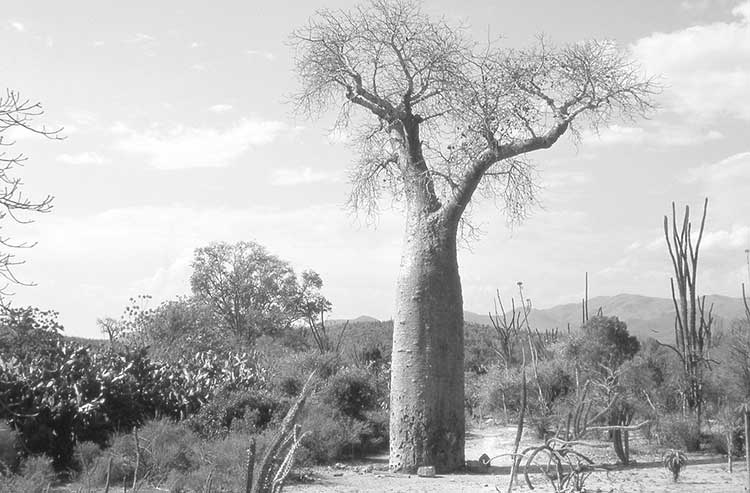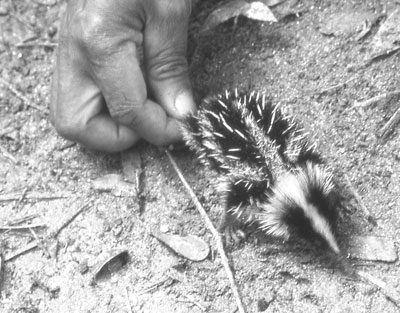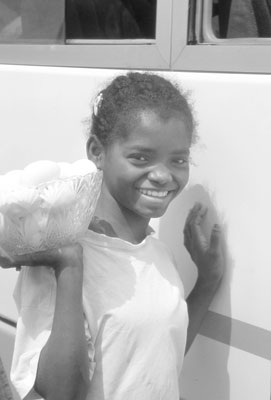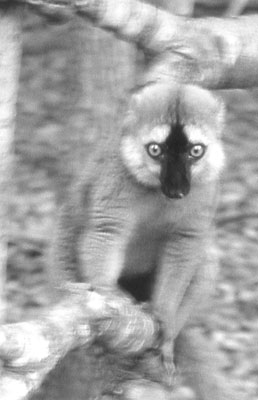The otherworldly creatures of Madagascar
by John C. Deppman, Fort Myers, FL (Second of two parts, go to part one)
After leaving Anakao, on the southwest coast of Madagascar, we spent two nights in Ifaty at the elegant Paradisio Hotel, taking day trips into the spiny forest.
The spiny forest
The phrase “spiny forest” refers to a type of forest unique to Madagascar and characterized primarily by endemic cactus-like trees and plants. It is aptly named, for almost every plant is prickly, thorny, spiny or barbed.
The soil is comprised of fine sand, and as we walked along the sandy trails through the forest, small thorns got into my sandals and I had to keep stopping to remove them. After that, I learned to wear socks and sneakers.
The spiny forest was bright and sunny due to the fact that the trees do not grow high, except for the occasional stately baobab tree. The baobab grows in dry regions and can be distinguished by its huge, smooth trunk with a small branch structure. The trunk is composed of porous wood, which stores water during droughts. The trees are picturesque and often live for hundreds of years.
There are eight different species of baobab trees in the world. Only one is found in all of Africa and one in Australia, and the remaining six are located only in Madagascar.
Ampijoroa Field Station
Leaving the spiny forest, we flew from Tuléar (Toliara) to Tana (Antananarivo), then on to Mahajanga, located on the northwest coast. Ecotourists are attracted to the Mahajanga area because of the Ampijoroa Field Station, located in Ankarafantsika Nature Reserve. The field station is used by researchers studying the indigenous flora and fauna of the area.
To stay there, it was necessary to camp, and this was certainly the most rustic portion of our trip. And the hottest as well. The inside of my tent reached 117°F in the daytime and never went below 85° during the two nights we were there.
The facilities were basic. The lights in the showers worked sporadically.
On my first trip to the shower, I encountered a Madagascar giant hissing cockroach in my path. Found nowhere else, it is about two inches long and, when threatened, actually hisses. Needless to say, I gave it a wide berth.
Once in the shower, I shared it with two green tree frogs that were on the walls — all in a day’s work here.
Across the highway from the field station is a hiking path along a small lake, and we went there twice in search of wildlife. The avian highlight of the trip occurred when we saw three Madagascar fish eagles (two adults and one juvenile).
It is the largest raptor in Madagascar and one of the rarest birds of prey in the world. Huge brown eagles with white heads, they are regal in bearing. The species is officially listed as critically endangered and it is estimated that fewer than 100 pairs remain in the wild.
Along the pathway, we also saw species of vangas, couas and mesites, families of birds found only in Madagascar.
By the lake, a woman washing her laundry with her children playing nearby did not seem to be bothered by the two large crocodiles sunning themselves not far from her on the muddy bank.
Weird and wonderful creatures
Lemurs were plentiful in the forest and could be found even around the campground at Ampijoroa. Endearing panda-like lemurs known as Coquerel’s sifakas, although rare elsewhere, were easily seen there as they cavorted about the camping area, clinging to the trunks of short trees and gazing back at us with their big eyes from just above our heads.
Later, on an evening trek through the forest using only our headlamps and flashlights, we saw nocturnal lemurs, not to mention bats, chameleons, lizards and even a Madagascar hog-nosed snake.
At the Ampijoroa Field Station they have a special project for breeding and raising the radiated tortoise. Endemic to Madagascar, it is severely endangered due to poaching for the pet trade. This large tortoise can live up to 100 years, and its population, at least in captivity, seems to have stabilized thanks to several successful breeding programs throughout the country.
On an afternoon circuit near my tent, I experienced a most remarkable phenomenon. Branches of shrubs were covered with fluffy white flowers, but as I put my hand near to touch them they all moved to the back side of the branch. I couldn’t believe it; the flowers were alive!
It was an Alice-in-Wonderland-like sensation. I repeated the exercise several times, and each time the flowers scurried around to the other side of the branch.
I later learned that they were wooly aphids, which appear flower-like as a protective device so predators, such as birds, won’t recognize them.
Andasibe-Mantadia National Park
From Antananarivo, we rode east by bus to Perinet and our lodge, called Feon’ny Ala. We spent four enjoyable nights there in individual bamboo A-frame bungalows with en suite facilities.
The dining hall easily accommodated our group plus another, from France, providing a selection of Chinese and Malagasy dishes. This proved to be an excellent location from which to explore the several parks in the vicinity.
Altogether, during day trips and night walks through Mantadia National Park and Perinet Reserve, we saw nine different species of lemurs. The most remarkable had to be the indri, a large black-and-white lemur and the only one without a tail. Primarily arboreal, they rarely descend from the trees, but they can be seen making magnificent leaps from one branch to another.
But most unique is their haunting song, or bellow, which can be heard only for a short time each day. Carrying for miles throughout the rainforest, it starts with one indri, then others in the family group join in, and, before long, other distant indri groups can be heard.
To me, the song sounded like the noise that might be made by a whale in an echo chamber deep in the ocean. Others in our group described it as “eerie and wailing” and “clarinet-like,” so I would say it is a sound better heard than described.
We managed to see a tenrec while hiking through the forest at Mantadia. I have to admit I had never heard of tenrecs prior to this trip, but they are fascinating small, rodent-like mammals with pointy noses.
These evolutionarily primitive mammals radiated throughout the island over the millennia, various species filling different environmental niches. One type is web-footed and lives near streams, while a few of the species are prickly like porcupines and the rest are furry. (More tenrec information can be found at www.tenrec.org/fieldolson.htm.)
Our local guide caught a lowland streaked tenrec that was foraging among leaves in search of worms and held it for us to inspect. What a strange-looking little creature it was, with black and white quills, a yellow collar and a yellow streak extending down its head to the tip of its tapered nose.
During our four days in Perinet we managed to see 17 additional bird species that we had not seen previously on the trip, including two owls, a rail and the Madagascar pygmy kingfisher. Overall, during the trip I saw some 160 species of birds, over half of which are endemic to the island, and over 20 species of lemurs.
Is this trip for you?
A trip like this is not for everyone. I like to think of myself as an adventure traveler, but I have to admit there were times when I had seen enough creepy, crawly things. It certainly helps to have a high tolerance for the occasional cockroach, both hissing and otherwise. Small leeches found a few of us in the wetter areas, but they were easily removed.
Scorpions are the only real danger, and they occur just in the dry regions; we checked our shoes each morning while there. For the most part, we appreciated the plentiful supply of moths, butterflies, chameleons, geckos, stick bugs, frogs, millipedes, lizards and spiders.
During the first week, everyone on the trip, save one, became ill. The primary complaints were stomach distress, sunstroke and motion sickness from the bus. Everyone recovered nicely, and we were generally healthy for the second and third weeks.
Most agreed it was important to carry Cipro, a strong antibiotic, or its generic equivalent, Ciprofloxacin. Those who did not bring any from home discovered that Ciprofloxacin was available over the counter in local pharmacies.
It was also recommended that we take Malarone™, an antimalarial medication, while in Madagascar.
The only safe water was bottled water, and we drank a lot of it. At lunch and dinner we drank canned soft drinks or the local Three Horses Beer, which was quite good.
Breakfasts were usually Continental, while noontime and evening meals were mostly hearty and excellent, if a bit repetitive. Salads were generally shredded carrots and sliced cucumbers, sometimes served with shrimp.
Although I champion independent travel, I believe this is a trip best taken with a group. I was quite happy with Naturetrek (Cheriton Mill, Cheriton, Alresford, Hants, SO24 0NG, U.K.; visit www. naturetrek.co.uk), but I know there are several other companies that conduct tours to Madagascar.
Many British companies that focus on birding trips can be found at www.free-living.com/index.html. Most tours focus on lemurs and birdlife, with appropriate attention paid to the other wonders of the island.
The food
We were commonly offered a choice of zebu (humped cattle) or fish, with chicken as an occasional alternative. Rice is a staple in Madagascar and was available at almost every meal.
Zebus are often served kabob style with rice; they tasted like beef. The fish was freshly caught capitaine or tilapia, both tasty, and was also served with rice. The chicken we tried had scant amounts of meat and was tough.
Dessert was usually an option with both lunch and dinner. Fruit was always offered and guaranteed to be fresh and satisfying. The small, sweet kind of bananas that are difficult to find in the U.S. were ubiquitous and were sometimes presented with chocolate sauce or served flambéed. Papayas and mangoes were also a frequent choice. Other desserts we saw with some frequency were cake and vanilla flan.
Behind the bar in many of the hotels were many large-mouth containers filled with fresh fruit soaking in local rum. The rum, thus infused, would be ladled out and served straight. I tried several flavors and enjoyed them.
Is Madagascar safe to visit?
A disputed presidential election held on Dec. 16, 2001, caused political unrest in the country for a while. The incumbent, Didier Ratsiraka, was apparently narrowly defeated by the popular mayor of Antananarivo, Marc Ravalomanana; however, both men declared victory.
Ravalomanana took control of Tana, and Ratsiraka moved to the countryside, which was his power base. Six months of difficulty ensued, locally referred to as a strike.
Supporters of the former president cut off access to and from the capital city by blowing up bridges, thereby preventing trucks with supplies from entering. There was little disturbance in terms of bloodshed, but both people and businesses suffered. A vote recount eventually verified that the mayor had won the election, although the incumbent refused to accept it. With the passage of time, however, both military and popular support transferred to Ravalomanana, who is now widely considered to be the president.
Some evidence remains of the strike in the form of damaged bridges, but we had no difficulty as we traveled around the country, and we felt no danger. The Malagasy people pride themselves in being peaceable.







